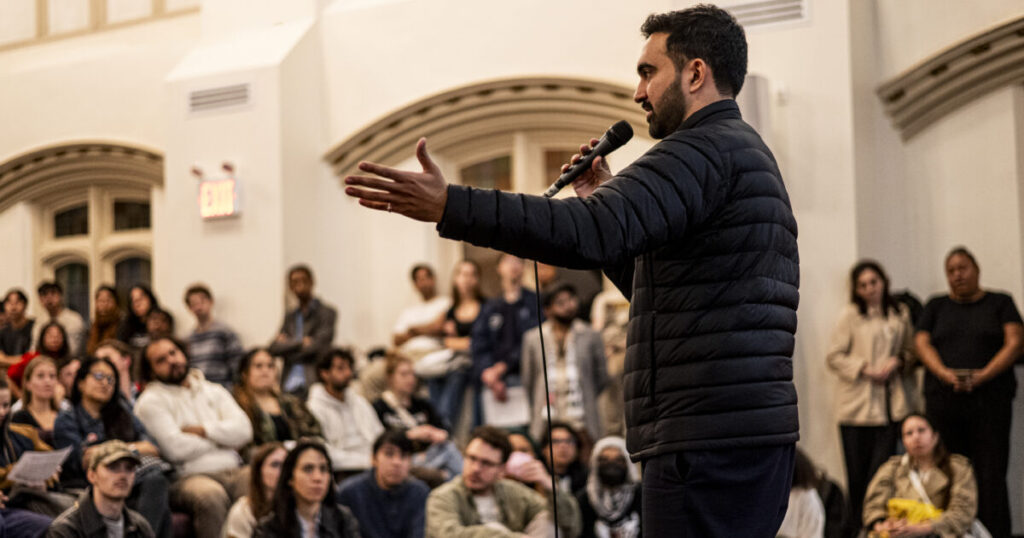New York City’s mayoral race uses a unique system called ranked choice voting, which fundamentally alters how winners are determined. Unlike traditional elections where voters select a single candidate, New York voters can rank up to five candidates in order of preference on their ballot.
If no candidate receives more than 50% of the first-choice votes, a computerized elimination process begins. The candidate with the fewest first-place votes is eliminated, and those votes are redistributed to each voter’s next-ranked choice. This process continues through multiple rounds—potentially factoring in third, fourth, and even fifth choice, until only two candidates remain. The final winner is the one with majority support among the remaining ballots, though that may not be the candidate most voters originally preferred.
In the June 2025 Democratic primary, the ranked choice system significantly altered the initial results. Zohran Mamdani led on election night with 43.5% of first-choice votes, but after several rounds of eliminations and redistributions, he was declared the winner with 56%, while Andrew Cuomo finished with 44%.
This system creates a far more unpredictable election environment. Candidates who appear to hold solid leads on election night can end up losing, or winning, once all voter preferences are fully counted and redistributed.
Ranked choice voting can appear unfair because a candidate with fewer first-choice votes may ultimately win the election. A key technical flaw is “ballot exhaustion,” which happens when voters rank too few candidates to remain in the final rounds. If all of a voter’s selected candidates are eliminated before the last round, their ballot is no longer counted in the final outcome.
A 2015 study of 600,000 votes cast in four local elections in Washington State and California found that winners in all four elections received less than a majority of total votes cast. Studies have found exhaustion rates ranging from 9.6 percent to over 27 percent in some elections, meaning the winner may only represent a majority of remaining votes, not all votes cast.
The increased complexity of ranked choice voting is another major issue. It’s absurd that Democrats, who argue voter ID is too confusing for many people, somehow believe voters can understand and navigate ranked choice voting, and remember to rank enough candidates just to avoid having their ballot disqualified early in the process.
Studies have found that one in twenty voters improperly mark their ballots in ranked choice voting contests. Former California Governor Jerry Brown vetoed a 2016 bill to expand ranked choice voting in his state, calling it “overly complicated and confusing,” and saying it “deprives voters of genuinely informed choice.” The system requires voters to research multiple candidates rather than simply selecting one, which may favor those with more time and greater access to information. In some jurisdictions, the number of candidates that can be ranked is limited, for example, allowing voters to choose only three candidates even when more are on the ballot.
There is also the risk of tactical gaming, where voters strategically rank candidates to eliminate viable opponents. Professor James Gimpel, an expert on voter behavior, testified that ranked choice voting requires voters to make predictions about likely outcomes, and that “a portion of the voting public has insufficient interest and information to make a meaningful assessment about likely outcomes.”
Additionally, the computerized calculations involved raise transparency concerns. The complex, mathematical redistribution process makes it much harder for outside groups to verify results compared to traditional vote counting.
Ranked choice voting is expected to favor Mamdani due to strategic coalition-building among liberal candidates. Mamdani and City Comptroller Brad Lander cross-endorsed each other, urging their supporters to rank the other candidate second. This coalition strategy was designed to block Cuomo from winning by forming a unified front—without the traditional “spoiler effect,” where similar candidates split the vote.
The system allowed multiple liberal candidates to coordinate their campaigns without fear of dividing the anti-Cuomo vote. After Mamdani’s campaign reached fundraising limits, he urged supporters to donate to fellow anti-Cuomo candidate Adrienne Adams. Multiple candidates, political committees, and the Working Families Party mounted coordinated efforts urging voters not to rank Cuomo.
In the primary, When the ranked choice tabulation occurred, the Board of Elections eliminated all candidates except Mamdani and Cuomo as a batch, including third-place finisher Brad Lander who received 11.2% of first-choice votes. This allowed the second-choice preferences of eliminated progressive candidates’ supporters to flow primarily to Mamdani, enabling him to increase his vote share from 43.5% on election night to 56% in the final tally. And similar mathematics are expected to polay out in the actual election
The system allowed multiple liberal candidates to coordinate their campaigns without fear of splitting the anti-Cuomo vote. After Mamdani’s campaign hit fundraising limits, he urged supporters to donate to fellow anti-Cuomo candidate Adrienne Adams. Multiple candidates, political committees, and the Working Families Party mounted coordinated efforts urging voters not to rank Cuomo.
In the primary, when the ranked choice tabulation occurred, the Board of Elections eliminated all candidates except Mamdani and Cuomo in a single batch, including third-place finisher Brad Lander, who had received 11.2% of first-choice votes. This allowed the second-choice preferences of eliminated progressive candidates’ supporters to flow primarily to Mamdani, increasing his vote share from 43.5% on election night to 56% in the final tally. Similar mathematics are expected to play out in the general election.
Read the full article here
